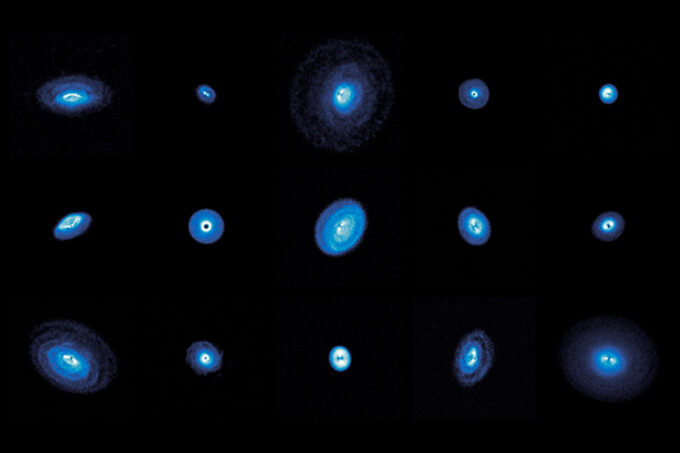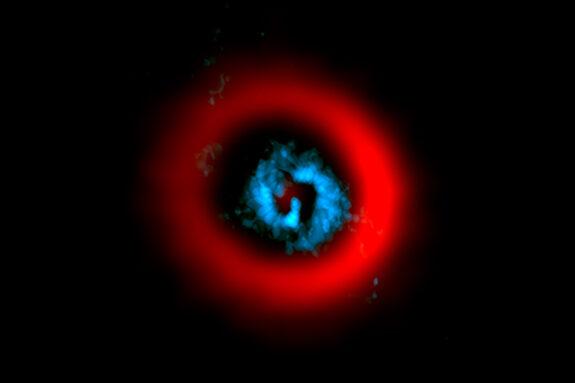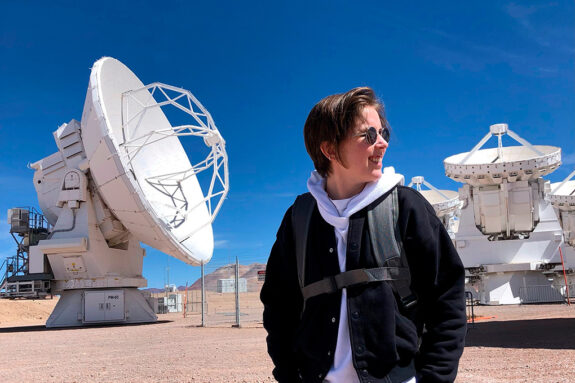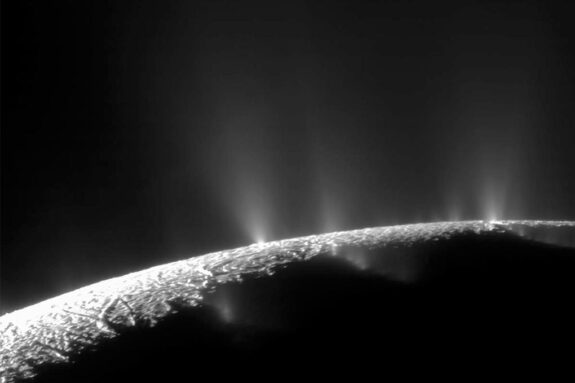New research, data advances understanding of early planetary formation

Deep ALMA observations of 12CO emission, (all sources are to scale to emphasize size differences) from fifteen protoplanetary disks reveal a stunning range of structures in the gas morphology including gaps, rings and spirals. Image credit: Richard Teague/exoALMA Collaboration
A team of international astronomers led by Kerr-McGee Career Development Professor Richard Teague in the department of Earth, Atmospheric and Planetary Sciences (EAPS) has gathered the most sensitive and detailed observations of 15 protoplanetary disks to date, giving the astronomy community a new look at the mechanisms of early planetary formation.
“The new approaches we’ve developed to gather this data and images are like switching from reading glasses to high-powered binoculars—they reveal a whole new level of detail in these planet-forming systems,” says Teague.
Their findings were published in a special collection of 17 papers in the Astrophysical Journal of Letters, with several more coming out this summer. It sheds light on a breadth of questions, including ways to calculate the mass of a disk by measuring its gravitational influence and extracting rotational velocity profiles to a precision of meters per second.
Protoplanetary disks are a collection of dust and gas around young stars, from which planets are created. Observing the dust in these disks is easier because it is brighter; but the information that can be gleaned from dust alone is only a snapshot of what is going on. Teague’s research focus has shifted attention to the gas in these systems, as they can tell us more about the dynamics in a disk, including properties such as gravity, velocity and mass.
To achieve the resolution necessary to study gas, the exoALMA program spent five years coordinating longer observation windows on the Atacama Large Millimeter/submillimeter Array (ALMA) in Chile. As a result, the international team of astronomers, many of whom are early career scientists, were able to collect some of the most detailed images ever taken of protoplanetary disks.
“The impressive thing about the data is that it’s so good, the community is developing new tools to extract signatures from planets,” says Marcelo Barraza-Alfaro, a postdoc in the Planet Formation Lab and a member of the exoALMA project. Several new techniques to improve and calibrate the images taken were developed to maximize the higher resolution and sensitivity that was used.
As a result, “we are seeing new things that require us to modify our understanding of what’s going on in protoplanetary disks,” he says.
One of the papers with the largest EAPS influence explores planetary formation through vortices. It has been known for some time that the simple model of formation often proposed, where dust grains clump together and “snowball” into a planetary core, is not enough. One possible way to help is through vortices, or localized perturbations in the gas that pull dust into the center. Here, they are more likely to clump, the way soap bubbles collect in a draining tub.
“We can see the concentration of dust in different regions, but we cannot see how it is moving,” says Lisa Wölfer, another postdoc in the Planet Formation Lab and first author on the paper. While astronomers can see that the dust has gathered, there isn’t enough information to rule out how it got to that point.
“Only through the dynamics in the gas can we actually confirm that it’s a vortex and not something else creating the structure,” she says.
During the data collection period, Teague, Wölfer and Barraza-Alfaro developed simple models of protoplanetary disks to compare to their observations. When they got the data back, however, the models couldn’t explain what they were seeing.
“We saw the data and nothing worked anymore. It was way too complicated,” says Teague. “Before, everyone thought they were not dynamic. That’s completely not the case.”
The team was forced to reevaluate their models and work with more complex ones incorporating more motion in the gas, which take more time and resources to run. But early results look promising.
“We see that the patterns look very similar; we think this is the best test case to study further with more observations,” says Wölfer.
The new data, which has been made public, comes at a fortuitous time: ALMA will be going dark for a period in the next few years while it undergoes upgrades. During this time, astronomers can continue the monumental process of sifting through all the data.
“It’s going to just keep on producing results for years and years to come,” says Teague.


